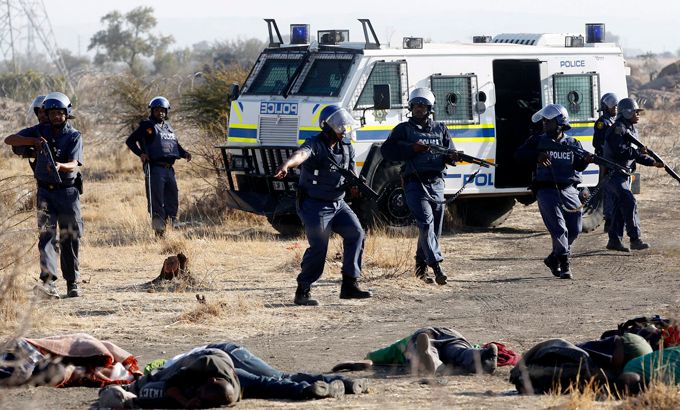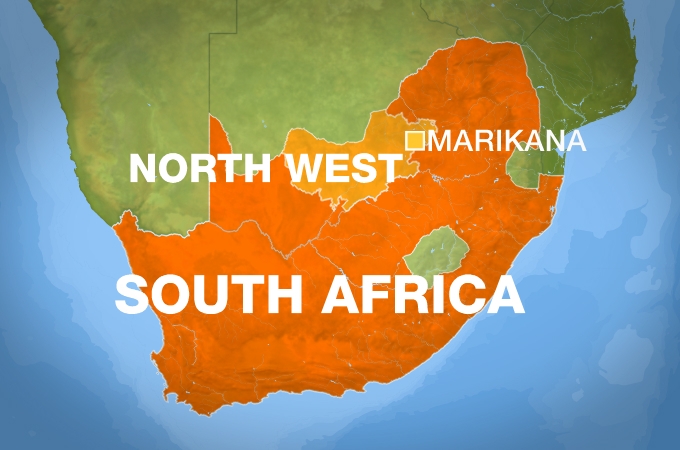South Africa orders probe into miners’ deaths
President Jacob Zuma says the cause of the “shocking” deaths of 34 workers shot by police must be found.

South African President Jacob Zuma has launched an investigation into the deaths of 34 workers who were shot by police on Thursday during a protest over pay at the Lonmin platinum mine in Marikana, where thousands are still protesting.
Zuma, who cut short a trip to a regional summit in neighbouring Mozambique to address the crisis, said on Friday that the official probe into the incident was necessary “to get to the truth”.
“We have to uncover the truth about what happened here. In this regard, I’ve decided to institute a commission of inquiry. The inquiry will enable us to get to the real cause of the incident and to derive the necessary lessons, too,” he said.
The incident, 100km northwest of Johannesburg, which police said was an act of self-defence, appears to be one of the bloodiest police operations since the end of white-minority rule in 1994 in Africa’s biggest economy.
“It is clear there is something serious behind these happenings and that’s why I have taken a decision to establish the commission because we must get to the truth,” Zuma said.
“This is a shocking thing. We do not know where it comes from and we have to address it.”
The president announced the investigation only hours after National Police Commissioner Riah Phiyega told a press conference that police had acted in self-defence.
Along with the 34 deaths, Phiyega said 78 people had been injured and 259 arrested in Thursday’s violence.
She added that it was too soon for “blaming”.
“The police members had to employ force to protect themselves from the charging group,” she said.
“This is no time for blaming, this is not time for finger pointing. It is a time for us to mourn a sad and dark moment we experience as a country.”
‘Mine Slaughter’
The White House said the US was “saddened” by the deaths and expressed confidence in the government probe.
“We note President Zuma’s statement of shock and dismay and the remarks of other South African officials on these events and their efforts to resolve the situation without further bloodshed,” White House deputy press secretary Josh Earnest told reporters.
 |
“We are confident that the South African government will investigate the facts around this case and, as always, we encourage all parties to work together to resolve the situation peacefully.”
Local newspaper headlines screamed “Bloodbath”, “Killing Field” and “Mine Slaughter”, with graphic photographs of heavily armed police officers walking casually past the bloodied corpses of men lying crumpled in the dust.
In a front page editorial, The Sowetan newspaper questioned what had changed since 1994.
“It has happened in this country before where the apartheid regime treated black people like objects,” the paper said. “It is continuing in a different guise now.”
Giving their version of Thursday’s violence, police said up to 3,000 striking drill operators armed with machetes and sticks, and some with firearms, ignored orders to disperse.
The crowd had charged at the line of officers, but it remained unclear what prompted this behaviour, Zweli Mnisi, the police ministry spokesman, said.
Witnesses said a water cannon, stun grenades and tear gas were first used to try and break up the crowd. The shooting happened after police failed to get the striking miners to hand over their weapons.
Former African National Congress youth Leader Julius Malema has thrown his support behind the striking miners, saying that the police response was “excessive”, even if a protester did open fire on the police.
“If they are well-trained police, they are supposed to isolate that indivudual and take him out,” said Malema, who arrived at the Marikana township on Saturday.
In an earlier statement, the South African Police Service said its officers were “viciously attacked by the group, using a variety of weapons, including firearms. The police, in order to protect their own lives and in self-defence, were forced to engage the group with force”.
The incident, captured by Reuters photographers, drew condemnation from South African’s main opposition party, the Democratic Alliance, social media users and evoked comparisons with apartheid-era brutality.
‘Senseless violence’
Zuma said in a statement on Thursday: “We believe there is enough space in our democratic order for any dispute to be resolved through dialogue without any breaches of the law or violence.
“We call upon the labour movement and business to work with government to arrest the situation before it deteriorates any further.”
The Sowetan reported on Thursday that police officers earlier said that negotiations with leaders of rival labour union Association of Mineworkers and Construction Union (AMCU) had broken down, leaving no option but to disperse strikers by force.
“Today is unfortunately D-day,” Dennis Adriao, a police spokesman, was quoted as saying on Thursday.
While the initial walkout and protest focused on wages, the ensuing violence has been fuelled by the struggles between the dominant National Union of Mineworkers (NUM) and the upstart and more radical AMCU.
Disputes between the two unions escalated into violence earlier this year at another mine.
Roger Phillimore, Lonmin’s chairman, issued a statement on Friday saying the deaths were deeply regretted. But he emphasised the mine considered it “clearly a public order rather than a labour relations associated matter”.
The unrest at the Lonmin mine began on August 10, as about 3,000 workers walked off the job over pay in what management described as an illegal strike.
Before Thursday’s shooting, the protests and ensuing violence had killed at least 10 people in Marikana, including two police officers.
It has also drastically affected production at the mine.